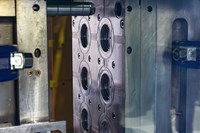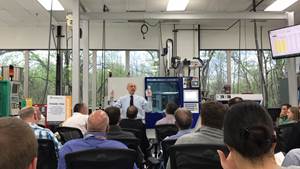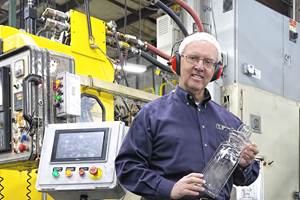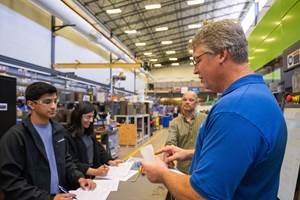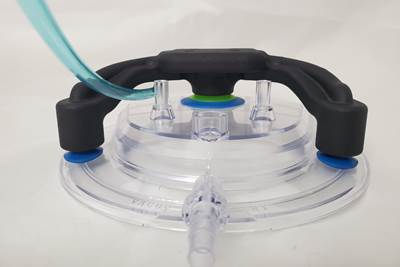Can Robots Bridge the Skills Gap?
Robot sales break records as manufacturers’ struggles to hire skilled workers heighten—industry watchers see a direct correlation.
On Dec. 12, the Association for Advancing Automation (A3; Ann Arbor, Mich.) released a report on automation technology sales in North America for the first nine months of 2017, noting that the industry was “shattering” records in sales of robotics, machine vision, motion control, and motor technologies.
Two days later on Dec. 14, the Plastics Industry Association (PLASTICS) hosted a webinar—Future Growth Opportunities and the Current State of the U.S. Plastics Industry—breaking down the sector’s threats and opportunities, among other topics. PLASTICS President and CEO Bill Carteaux opened the webinar and stated directly at the end of his comments that, “The skills gap threatens continued growth in our industry and all U.S. manufacturing.”
During a Q&A, PLASTICS Chief Economist Perc Pineda expanded on the skills gap challenge.
“I think the U.S. manufacturing sector is at crossroads,” Pineda explained, noting that companies PLASTICS speaks with say they cannot “find enough people to work—people who are actually qualified—not just for mundane jobs, but people who have skills.”
In response to not finding human labor, and in a bid to be more efficient and cost competitive, these plastics firms have increasingly sought to “mechanize more and more operations”, according to Pineda. They are doing this at a time when automation innovations and new technologies like artificial intelligence have come along to present solutions that go well past pick-and-place. Pineda says automation can serve as a short- to medium-term answer to labor market tightening, with a net-positive effect, but at some point, skilled people with actual vs. artificial intelligence will be required.
“We’re on the verge of the skills gap going from anecdotal to empirical,” Carteaux said. “This will start to impede business growth as companies can’t find qualified hires.” Part of the challenge is getting more young people in industry to take on today’s factory jobs. “We need to train people for the jobs we have rather than the jobs we used to have.”
Until that happens, companies are automating like crazy. Per the A3 report, covering the first nine months of 2017 in North America:
- There were 27,294 robot orders valued at approximately $1.473 billion.
- This is the highest level ever recorded in any other year during the same time period.
- Figures represent growth of 14% in units and 10% in dollars over 2016.
- There were 25,936 robots valued at $1.496 billion shipped in North America.
- These are record highs representing growth of 18% in units and 13% in dollars over 2016.
These automation systems are not “dumb” in the sense of having vision/inspection capabilities, per the A3:
The North American Machine Vision Market continued its best start to a year ever in 2017, with growth of 14% overall to $1.937b, 14% in systems to $1.657b, and 14% in components to $271m. Each of those three categories set new records in the first nine months of this year….notable growth rates were Smart Cameras (21% to $295m), Lighting (20% to $54m), Software (16% to $15m), and Component Cameras (14% to $143m).
Some production has gone “lights out”, but can it get to “people free”?
Related Content
The Experience Curve and Well-Trained Process Technicians
Pairing external big picture training with internal job-specific instruction can help your process technicians meet quality expectations as well as production targets.
Read MorePaulson Training Acquired
Certus, a technical skills training business and portfolio company of private equity firm Ridgemont Equity Partners, has acquired the plastics processing training business founded in 1981.
Read MorePlastics Processors Who Hire ‘Second-Chance’ Workers Do Well by Doing Good
Two blow molders with long-standing programs of hiring formerly incarcerated low-level offenders have helped these individuals re-enter their communities and have benefited from an additional resource during chronic labor shortages.
Read MoreEducating the Next Generation of Plastics Professionals
These schools and local industry are working together to close the workforce gap in the plastics industry by offering hefty plastics curricula and training programs for degree-seeking students as well as current plastics employees looking to upskill.
Read MoreRead Next
Beyond Prototypes: 8 Ways the Plastics Industry Is Using 3D Printing
Plastics processors are finding applications for 3D printing around the plant and across the supply chain. Here are 8 examples to look for at NPE2024.
Read MoreLead the Conversation, Change the Conversation
Coverage of single-use plastics can be both misleading and demoralizing. Here are 10 tips for changing the perception of the plastics industry at your company and in your community.
Read More





